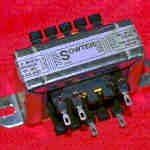OK great.
I gave Doc Hoyer a call becuase although I know some theory, I have never actually built a transformer based on anything more than a simple tuns calc and a gut feel for the core.
I learn a lot if I can keep him on track, but he has a ton of cool war stories related to audio, but you know how it goes......
"Lyman, when he was working for JPL, invented the split torroid...etc...etc..etc...for space missions so the transitors wouldn't pop.....the Langevine Leveline is beter than the 670, but nobody knows about it.....the Peerless K-241-D has the windings offset by 3/8 an inch....oh yeah, back to your transformer...."
I have a whole binder full of these precious tidbits!
Anyway, I think I got it all figured. You start from ther back.
And lets use 20 db, 10 db is too low.
so thats ten volts rms into 600.
an 8:1 makes it 80 rms = 114 volts peak = 228 p to p.
So your 250 B+ is perfect.
Now I can get B max.
But what frequency should I design for?
16 hertz is pretty common.
The core needs to double if we design for 8 hertz.
We try 16 and build it, then adjust later if needed.
Anyway, Michael Farady figured out that you need to move 100,000,000 lines of flux per second to make 1 volt rms.
10^8
so
B max = Volts sine wave rms times 10^8/4.44 times freq times Turns times cross section of core in cm^2.
so simplify constants along with 16 hertz and we have
Bmax = 1,407,000/Turns * Area
If you want a general formuala for B max based on 16 hertz you have
1,408,000 *E
------------------------
Turns * Core Cross Section (cm^2)
You can use that to figure out B max for any transformer you want to design.
Just use RMS volts that are going to be across the turns for variable "E".
Now we can make a chart with all differnt combos of turns and cross section that give B max to be whatever core material we use.
M6 = 18 k gauss
50/50 about 15 kGauss
Permalloy about 5 k gauss.
So I am developing the options for the core/coil assy as we speak.
Here comes the Boss.
:twisted:











